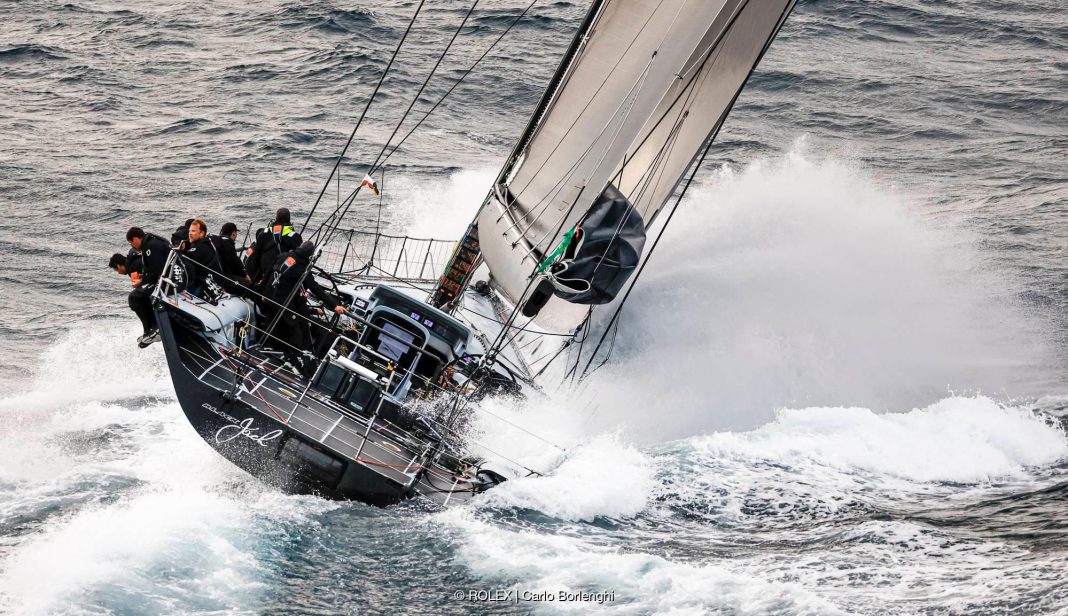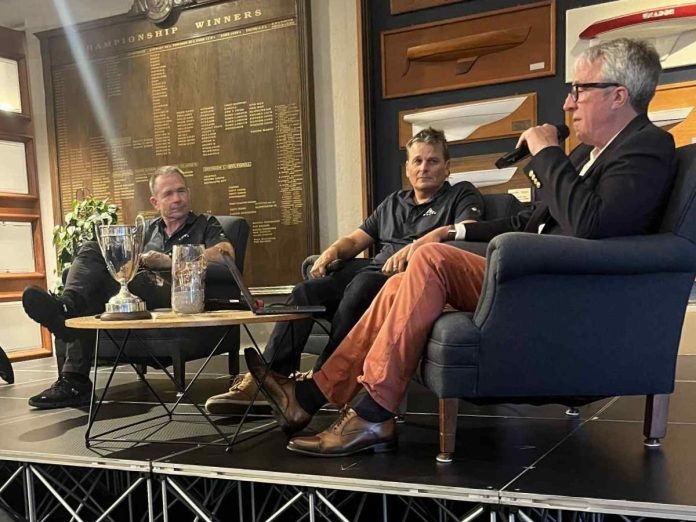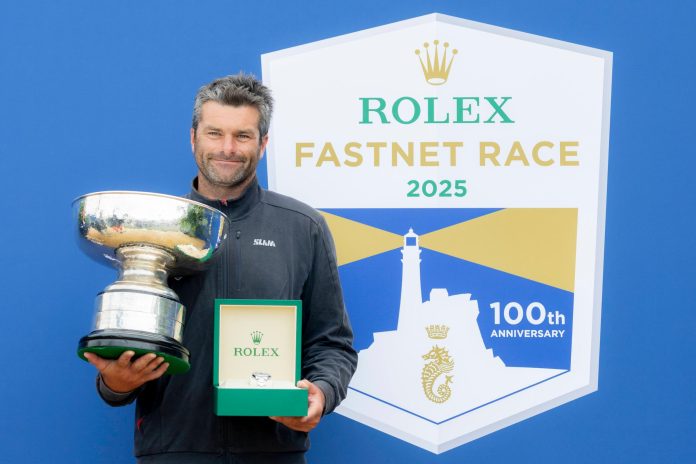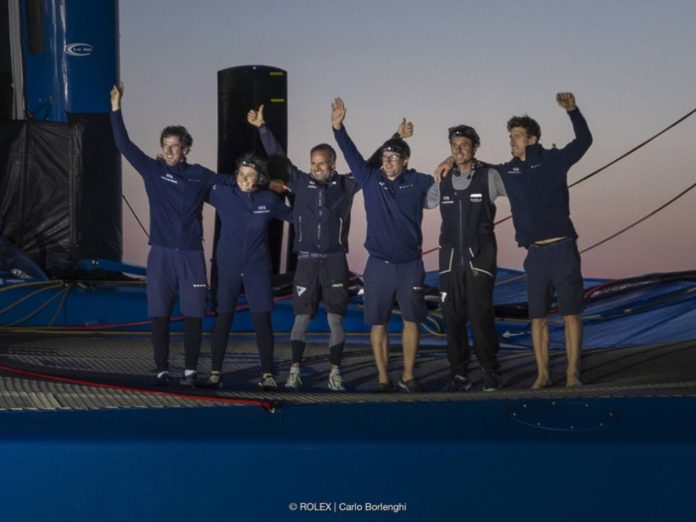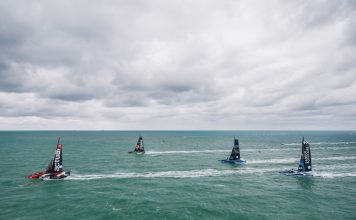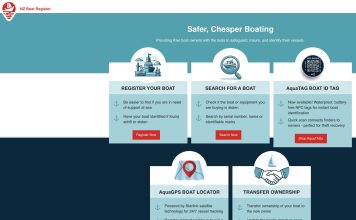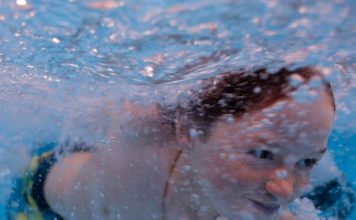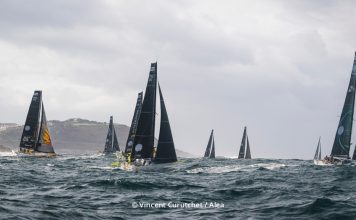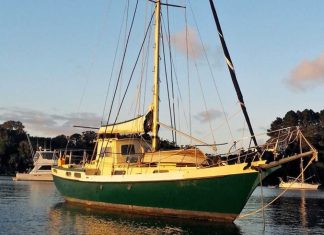As the 51st Rolex Fastnet Race surges toward its conclusion, attention is turning away from the record-chasing multihulls and onto the fierce battles playing out among the monohulls across multiple divisions. While the giant foiling Ultims may have stolen the early spotlight—SVR Lazartigue claiming multihull line honours in just under two days—the story of this year’s race is shaping up to be a tactical and hard-fought test among the monohulls, especially in IRC and the Admiral’s Cup classes.
Rolex Fastnet Race 2025 results: Ultims dominate centenary finish
At the front of the monohull fleet, the 100-foot Black Jack, representing the Royal Prince Alfred Yacht Club in Australia, was the first monohull to cross the finish line in Cherbourg, clocking an elapsed time of 2 days, 12 hours, 31 minutes. They were closely followed by SHK Scallywag 100 and Leopard 3, both arriving within 90 minutes. But it’s the corrected time rankings under IRC where the real contest is unfolding.
Leopard 3, the 2007 Farr-designed maxi skippered by Chris Sherlock, now holds the lead on handicap—proof of a shrewdly executed race that balanced outright speed with smart tactical calls. Black Jack sits second on corrected time, followed by Hong Kong’s SHK Scallywag, skippered by David Witt. While Black Jack took a more aggressive gybing route on the return leg from Fastnet Rock to Cherbourg, Leopard’s cleaner layline approach appears to have paid dividends.
According to Leopard’s tactician, the team made a critical decision after rounding the Rock, avoiding the patchy breeze mid-Channel. “We could see Black Jack going for the gybe early, but we stuck with our angle longer and found better pressure later on. That made the difference,” said navigator Will Best.
In IRC Zero, it’s the Australian crew aboard Whisper, a Judel/Vrolijk 60, who lead overall. Racing under the burgee of the Royal Ocean Racing Club of Australia, Whisper has maintained a strong course throughout and rounded the Fastnet Rock just behind the maxis. They now lead on corrected time from the highly anticipated Palanad 4, a Sam Manuard-designed 50-footer built for speed. Whisper’s heavier displacement and proven offshore track record are serving her well in the moderate upwind conditions of the first half of the course.
Also notable in IRC Zero is Warrior Won, an American entry showing solid performance across the Celtic Sea return. The top boats are now past the Scilly Isles and plotting final routing decisions across the English Channel—where tidal gates off Alderney and wind holes near Cap de la Hague can dramatically reshuffle standings.
The Admiral’s Cup teams are pushing hard. Black Pearl, skippered by Stefan Jentzsch for Germany, was first to round the Rock on the water, but it’s Beau Geste (Royal Hong Kong Yacht Club) and Jolt 3 (Yacht Club de Monaco) who lead on corrected time. The tight grouping of these modern raceboats speaks to the strength of international competition returning to the Admiral’s Cup format for the first time in decades.
In IRC One, the heavy-displacement Swan 53 Bedouin, skippered by Linda Goddard, is currently holding the top spot on corrected time. Despite her age and weight, Bedouin is taking advantage of her rating and performing remarkably well across the mixed conditions. “We’re not chasing line honours—our race is against the clock, and we’ve sailed conservatively but consistently,” Goddard noted via satellite phone. Her nearest rivals include Yes!, a JPK 1080, and Dawn Treader, an HH42 that’s overcome an early OCS penalty to fight back into contention.
IRC Two has developed into a strategic contest between inshore and offshore routes. Boats like Aurelia, a Ker 46 from Ireland, and Corazon, a J/122, gambled early by tacking inshore past the Scilly Isles—and are now seeing gains. Others, such as Desperado, played a conservative central route and may fall behind if the breeze builds inshore.
In IRC Three and Four, the battles are intense. Bellino, skippered by Rob Craigie with RORC Commodore Deb Fish co-skippering, leads IRC Three on corrected time, but has been trading the lead with Fujitsu British Soldier and Mzungu! as the breeze fluctuates. IRC Four has seen a west-to-east split in tactics, with Hakuna Matata and Zephyrin surging ahead after a well-timed turn north from the Scillies.
The Doublehanded fleet continues to perform impressively, showing that shorthanded crews are just as competitive in offshore conditions. Several entries across IRC Three and Four are being sailed by just two crew, yet still sit in the top five overall.
While the Ultim trimarans make headlines with speeds over 40 knots, the bulk of the Fastnet story is in these slower, tactical divisions where every tack and sail change could shift the standings. For most crews, the aim isn’t line honours—it’s beating the clock on corrected time, a test of endurance, navigation and conservative risk-taking.
For Kiwi interest, Beau Geste’s strong showing under the Royal Hong Kong Yacht Club flag and with links to New Zealand’s sailing scene provides a local hook in the Admiral’s Cup contest. With favourable winds forecast into Cherbourg, the next 24 hours will be decisive.
As the bulk of the 444-strong fleet converges on Cherbourg, it’s clear this year’s Rolex Fastnet Race isn’t about breakneck speeds or records—it’s a thinking sailor’s race. The monohulls are proving that tactical finesse, teamwork and resilience are what wins offshore.








